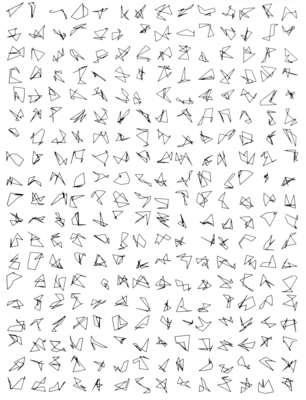Georg Nees was the first world-wide to publicly show his computer art (today often called digital art; a more precise term is algorithmic art).
In all likelihood, his solo show in rooms of the Studiengalerie of Technische Hochschule Stuttgart (now University of Stuttgart) was the first to present drawings that had been generated by running algorithms on a digital computer under control of a program. The drawings appeared in coded form on punched paper tape before being physically generated by a drawing machine, the legendary Zuse Graphomat Z64. This kind of automatic drawing machine, in the USA, was called flatbed plotter.
The exhibition took place under the auspices of the Ästhetisches Colloquium, a seminar permanently offered by Max Bense and his Institute of Philosophy and Theory of Knowledge (Philosophie und Wissenschaftstheorie). It opened on Thursday, February 4th, 1965, and was on display from February 5th to 19th, 1965.
For this occasion, one of the earliest publications ever on computer art appeared in print (“rot 19”, Stuttgart 1965). Max Bense contributed to it a short essay under the title projekte generativer ästhetik (also available in an English translation). Nees himself contributed short notes in German describing very succinctly the algorithms behind the accompanying drawings. These texts were in the form of of pseudo-code.
Georg Nees is one of the so-called “three big N’s” (the other two are A. Michael Noll and Frieder Nake). The word reminds of the fact that these three scientst-artists were the first to put up shows of algorithmic art, all in the year of 1965.
Nees was a mathematician who worked during all of his professional life for the Siemens AG in Erlangen (Germany). He gained his doctoral degree in philosophy from the University of Stuttgart in 1969. Max Bense was his doctoral advisor, Walter Knödel the second reviewer. The doctoral thesis was published as a book in 1969 (under the title, Generative Computergrafik). This was in all likelihood world-wide the first doctoral thesis on a topic of computer art.
Nees has exhibited extensively and world-wide. He has a long publishing record on topics of computer art, aesthetics, semiotics, artificial intelligence, and more. He was an honorary professor in applied computer science at University of Erlangen-Nürnberg (since 1977). Kunsthalle Bremen dedicated to him a retrospective exhibition in 2005. This museum also holds a large number of his works, including virtually all those that were published in his thesis.






